Management Accounting Systems and Techniques: A Comprehensive Report
VerifiedAdded on 2021/02/19
|21
|5858
|15
Report
AI Summary
This report provides a comprehensive overview of management accounting, exploring its core concepts, techniques, and applications. It begins by defining management accounting and distinguishing it from financial accounting, highlighting its internal focus and the diverse systems employed, such as job costing and inventory management. The report then delves into different methods used for management accounting reporting, including budgeting, cost reports, and performance evaluations. It emphasizes the importance of these reports in informed decision-making and financial risk assessment. A significant portion of the report is dedicated to cost analysis, with detailed explanations of fixed, variable, opportunity, and marginal costs. It demonstrates the preparation of income statements using both marginal and absorption costing methods, complete with cost calculations. The report also examines planning tools used in management accounting, such as budgeting, and how organizations can use management accounting to respond to financial problems. The assignment uses a case study of ABC LTD, a UK-based manufacturing company, to illustrate these concepts and their practical application.
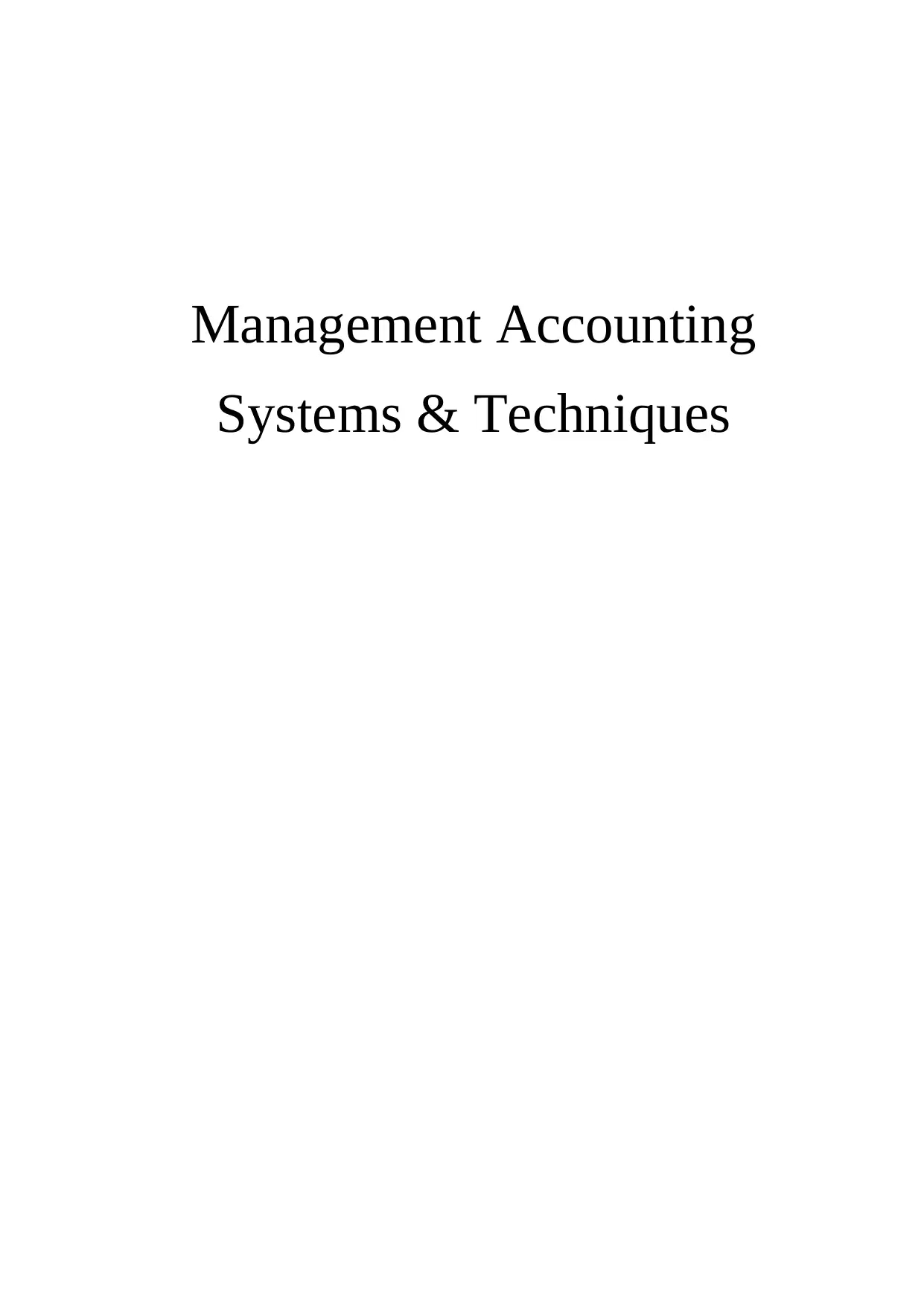
Management Accounting
Systems & Techniques
Systems & Techniques
Paraphrase This Document
Need a fresh take? Get an instant paraphrase of this document with our AI Paraphraser
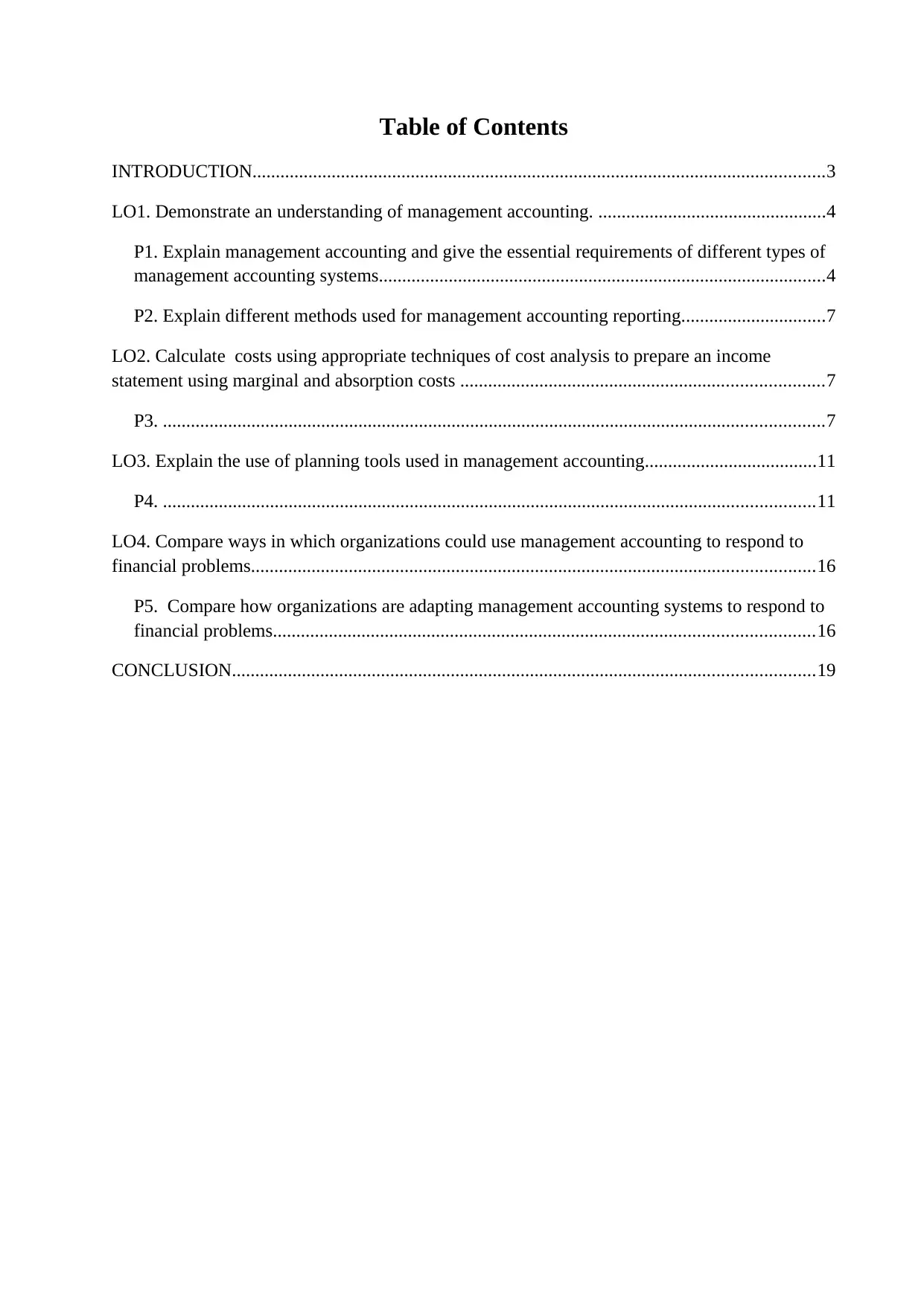
Table of Contents
INTRODUCTION...........................................................................................................................3
LO1. Demonstrate an understanding of management accounting. .................................................4
P1. Explain management accounting and give the essential requirements of different types of
management accounting systems................................................................................................4
P2. Explain different methods used for management accounting reporting...............................7
LO2. Calculate costs using appropriate techniques of cost analysis to prepare an income
statement using marginal and absorption costs ..............................................................................7
P3. ..............................................................................................................................................7
LO3. Explain the use of planning tools used in management accounting.....................................11
P4. ............................................................................................................................................11
LO4. Compare ways in which organizations could use management accounting to respond to
financial problems.........................................................................................................................16
P5. Compare how organizations are adapting management accounting systems to respond to
financial problems....................................................................................................................16
CONCLUSION.............................................................................................................................19
INTRODUCTION...........................................................................................................................3
LO1. Demonstrate an understanding of management accounting. .................................................4
P1. Explain management accounting and give the essential requirements of different types of
management accounting systems................................................................................................4
P2. Explain different methods used for management accounting reporting...............................7
LO2. Calculate costs using appropriate techniques of cost analysis to prepare an income
statement using marginal and absorption costs ..............................................................................7
P3. ..............................................................................................................................................7
LO3. Explain the use of planning tools used in management accounting.....................................11
P4. ............................................................................................................................................11
LO4. Compare ways in which organizations could use management accounting to respond to
financial problems.........................................................................................................................16
P5. Compare how organizations are adapting management accounting systems to respond to
financial problems....................................................................................................................16
CONCLUSION.............................................................................................................................19
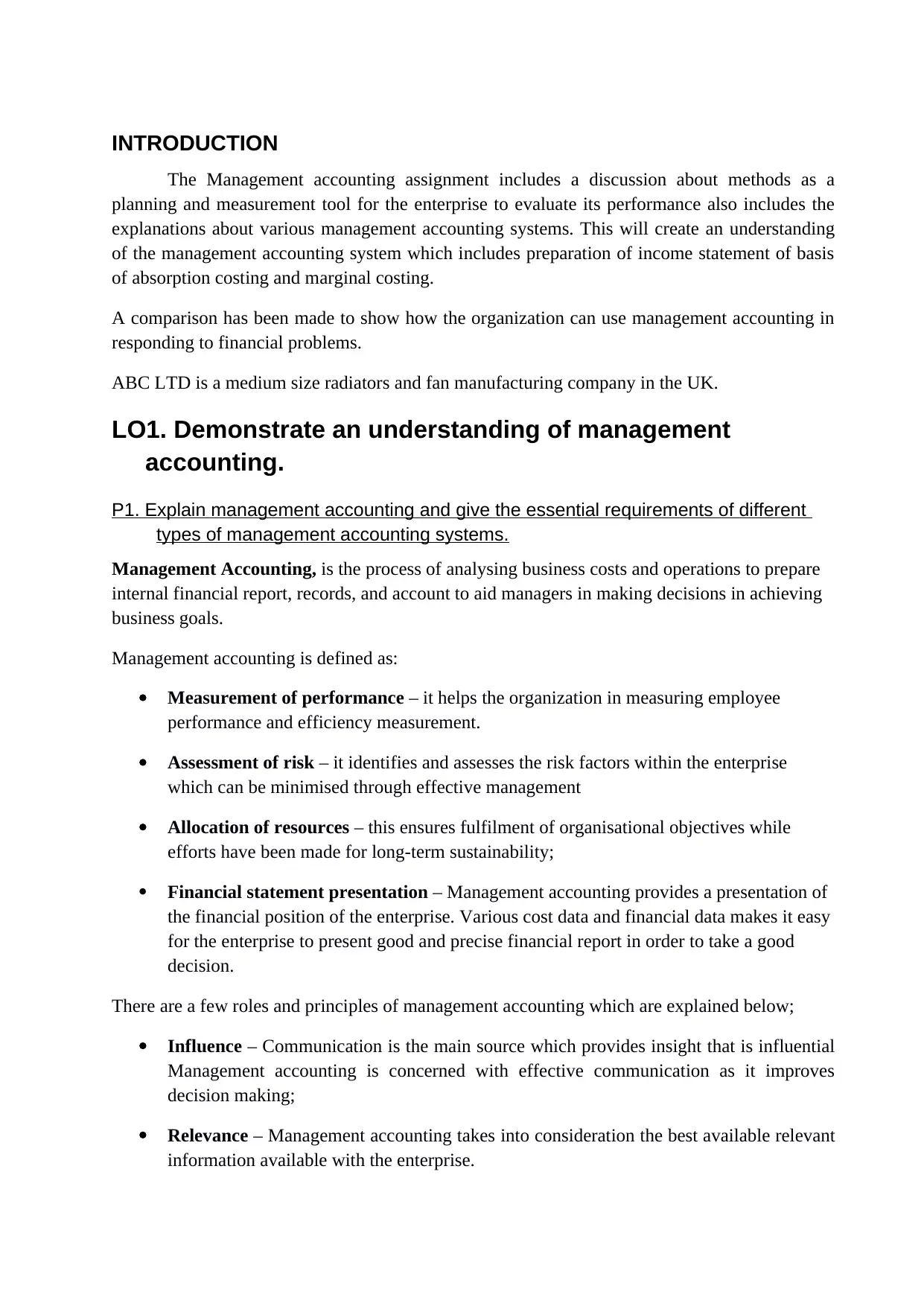
INTRODUCTION
The Management accounting assignment includes a discussion about methods as a
planning and measurement tool for the enterprise to evaluate its performance also includes the
explanations about various management accounting systems. This will create an understanding
of the management accounting system which includes preparation of income statement of basis
of absorption costing and marginal costing.
A comparison has been made to show how the organization can use management accounting in
responding to financial problems.
ABC LTD is a medium size radiators and fan manufacturing company in the UK.
LO1. Demonstrate an understanding of management
accounting.
P1. Explain management accounting and give the essential requirements of different
types of management accounting systems.
Management Accounting, is the process of analysing business costs and operations to prepare
internal financial report, records, and account to aid managers in making decisions in achieving
business goals.
Management accounting is defined as:
Measurement of performance – it helps the organization in measuring employee
performance and efficiency measurement.
Assessment of risk – it identifies and assesses the risk factors within the enterprise
which can be minimised through effective management
Allocation of resources – this ensures fulfilment of organisational objectives while
efforts have been made for long-term sustainability;
Financial statement presentation – Management accounting provides a presentation of
the financial position of the enterprise. Various cost data and financial data makes it easy
for the enterprise to present good and precise financial report in order to take a good
decision.
There are a few roles and principles of management accounting which are explained below;
Influence – Communication is the main source which provides insight that is influential
Management accounting is concerned with effective communication as it improves
decision making;
Relevance – Management accounting takes into consideration the best available relevant
information available with the enterprise.
The Management accounting assignment includes a discussion about methods as a
planning and measurement tool for the enterprise to evaluate its performance also includes the
explanations about various management accounting systems. This will create an understanding
of the management accounting system which includes preparation of income statement of basis
of absorption costing and marginal costing.
A comparison has been made to show how the organization can use management accounting in
responding to financial problems.
ABC LTD is a medium size radiators and fan manufacturing company in the UK.
LO1. Demonstrate an understanding of management
accounting.
P1. Explain management accounting and give the essential requirements of different
types of management accounting systems.
Management Accounting, is the process of analysing business costs and operations to prepare
internal financial report, records, and account to aid managers in making decisions in achieving
business goals.
Management accounting is defined as:
Measurement of performance – it helps the organization in measuring employee
performance and efficiency measurement.
Assessment of risk – it identifies and assesses the risk factors within the enterprise
which can be minimised through effective management
Allocation of resources – this ensures fulfilment of organisational objectives while
efforts have been made for long-term sustainability;
Financial statement presentation – Management accounting provides a presentation of
the financial position of the enterprise. Various cost data and financial data makes it easy
for the enterprise to present good and precise financial report in order to take a good
decision.
There are a few roles and principles of management accounting which are explained below;
Influence – Communication is the main source which provides insight that is influential
Management accounting is concerned with effective communication as it improves
decision making;
Relevance – Management accounting takes into consideration the best available relevant
information available with the enterprise.
⊘ This is a preview!⊘
Do you want full access?
Subscribe today to unlock all pages.

Trusted by 1+ million students worldwide
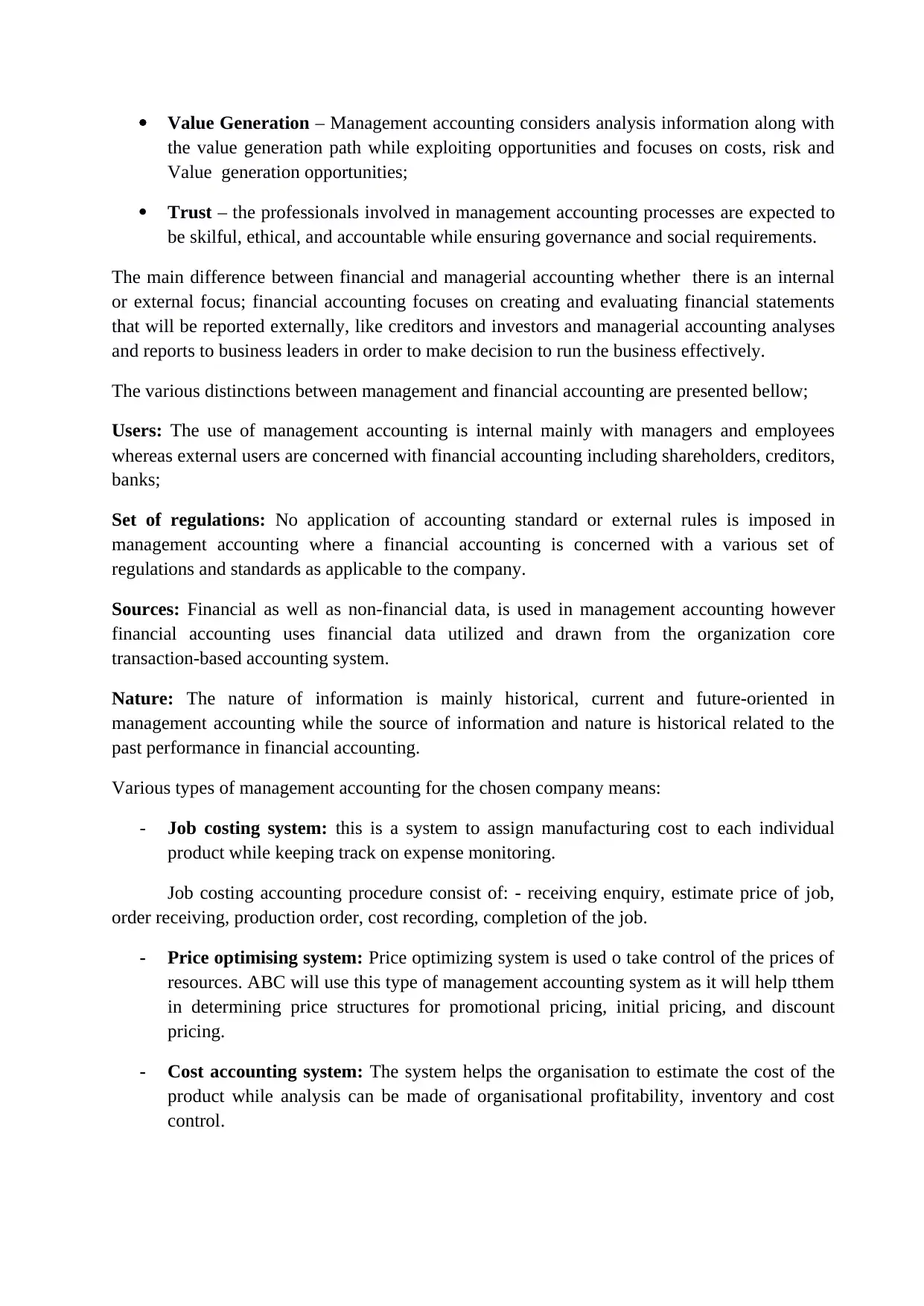
Value Generation – Management accounting considers analysis information along with
the value generation path while exploiting opportunities and focuses on costs, risk and
Value generation opportunities;
Trust – the professionals involved in management accounting processes are expected to
be skilful, ethical, and accountable while ensuring governance and social requirements.
The main difference between financial and managerial accounting whether there is an internal
or external focus; financial accounting focuses on creating and evaluating financial statements
that will be reported externally, like creditors and investors and managerial accounting analyses
and reports to business leaders in order to make decision to run the business effectively.
The various distinctions between management and financial accounting are presented bellow;
Users: The use of management accounting is internal mainly with managers and employees
whereas external users are concerned with financial accounting including shareholders, creditors,
banks;
Set of regulations: No application of accounting standard or external rules is imposed in
management accounting where a financial accounting is concerned with a various set of
regulations and standards as applicable to the company.
Sources: Financial as well as non-financial data, is used in management accounting however
financial accounting uses financial data utilized and drawn from the organization core
transaction-based accounting system.
Nature: The nature of information is mainly historical, current and future-oriented in
management accounting while the source of information and nature is historical related to the
past performance in financial accounting.
Various types of management accounting for the chosen company means:
- Job costing system: this is a system to assign manufacturing cost to each individual
product while keeping track on expense monitoring.
Job costing accounting procedure consist of: - receiving enquiry, estimate price of job,
order receiving, production order, cost recording, completion of the job.
- Price optimising system: Price optimizing system is used o take control of the prices of
resources. ABC will use this type of management accounting system as it will help tthem
in determining price structures for promotional pricing, initial pricing, and discount
pricing.
- Cost accounting system: The system helps the organisation to estimate the cost of the
product while analysis can be made of organisational profitability, inventory and cost
control.
the value generation path while exploiting opportunities and focuses on costs, risk and
Value generation opportunities;
Trust – the professionals involved in management accounting processes are expected to
be skilful, ethical, and accountable while ensuring governance and social requirements.
The main difference between financial and managerial accounting whether there is an internal
or external focus; financial accounting focuses on creating and evaluating financial statements
that will be reported externally, like creditors and investors and managerial accounting analyses
and reports to business leaders in order to make decision to run the business effectively.
The various distinctions between management and financial accounting are presented bellow;
Users: The use of management accounting is internal mainly with managers and employees
whereas external users are concerned with financial accounting including shareholders, creditors,
banks;
Set of regulations: No application of accounting standard or external rules is imposed in
management accounting where a financial accounting is concerned with a various set of
regulations and standards as applicable to the company.
Sources: Financial as well as non-financial data, is used in management accounting however
financial accounting uses financial data utilized and drawn from the organization core
transaction-based accounting system.
Nature: The nature of information is mainly historical, current and future-oriented in
management accounting while the source of information and nature is historical related to the
past performance in financial accounting.
Various types of management accounting for the chosen company means:
- Job costing system: this is a system to assign manufacturing cost to each individual
product while keeping track on expense monitoring.
Job costing accounting procedure consist of: - receiving enquiry, estimate price of job,
order receiving, production order, cost recording, completion of the job.
- Price optimising system: Price optimizing system is used o take control of the prices of
resources. ABC will use this type of management accounting system as it will help tthem
in determining price structures for promotional pricing, initial pricing, and discount
pricing.
- Cost accounting system: The system helps the organisation to estimate the cost of the
product while analysis can be made of organisational profitability, inventory and cost
control.
Paraphrase This Document
Need a fresh take? Get an instant paraphrase of this document with our AI Paraphraser
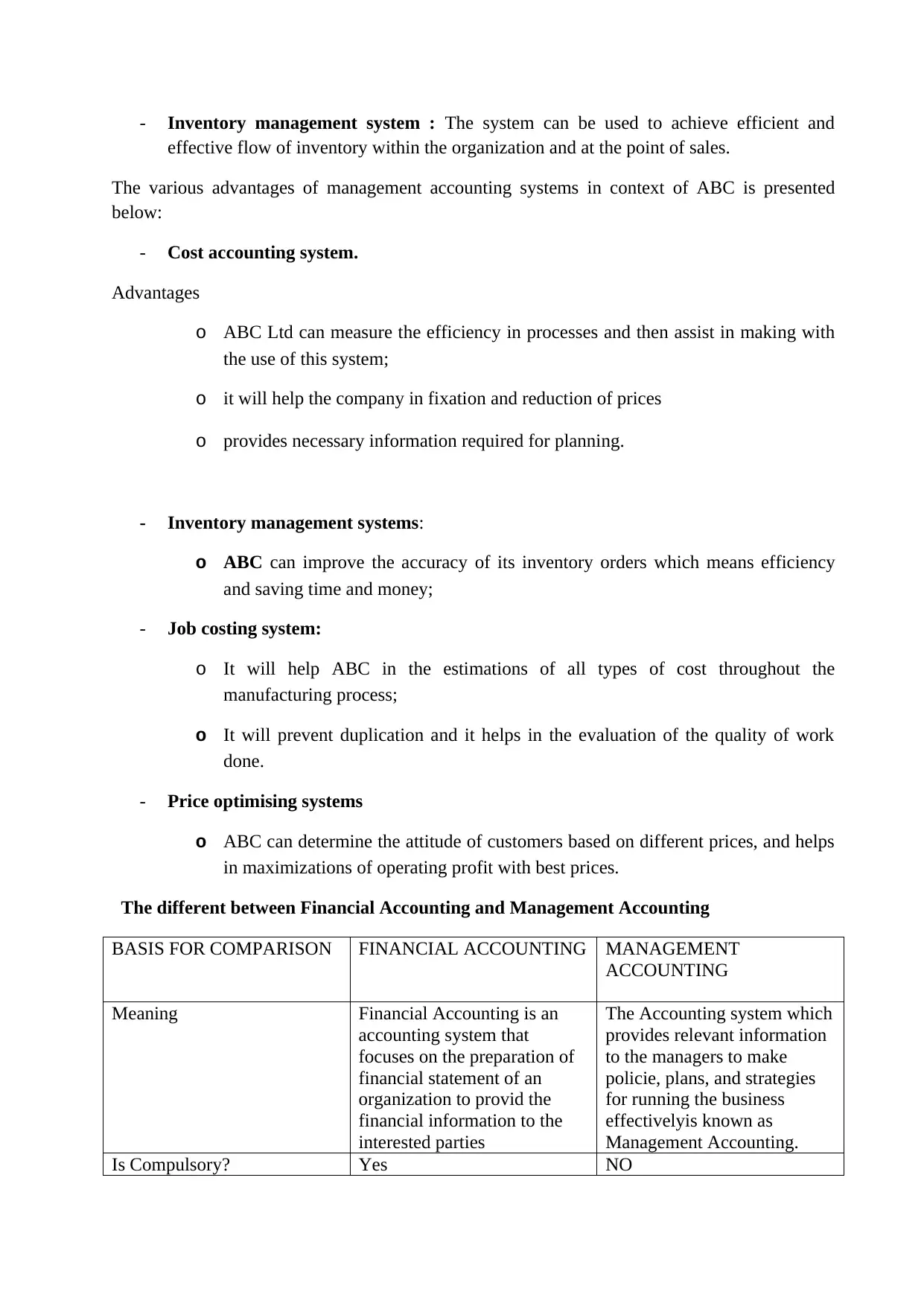
- Inventory management system : The system can be used to achieve efficient and
effective flow of inventory within the organization and at the point of sales.
The various advantages of management accounting systems in context of ABC is presented
below:
- Cost accounting system.
Advantages
o ABC Ltd can measure the efficiency in processes and then assist in making with
the use of this system;
o it will help the company in fixation and reduction of prices
o provides necessary information required for planning.
- Inventory management systems:
o ABC can improve the accuracy of its inventory orders which means efficiency
and saving time and money;
- Job costing system:
o It will help ABC in the estimations of all types of cost throughout the
manufacturing process;
o It will prevent duplication and it helps in the evaluation of the quality of work
done.
- Price optimising systems
o ABC can determine the attitude of customers based on different prices, and helps
in maximizations of operating profit with best prices.
The different between Financial Accounting and Management Accounting
BASIS FOR COMPARISON FINANCIAL ACCOUNTING MANAGEMENT
ACCOUNTING
Meaning Financial Accounting is an
accounting system that
focuses on the preparation of
financial statement of an
organization to provid the
financial information to the
interested parties
The Accounting system which
provides relevant information
to the managers to make
policie, plans, and strategies
for running the business
effectivelyis known as
Management Accounting.
Is Compulsory? Yes NO
effective flow of inventory within the organization and at the point of sales.
The various advantages of management accounting systems in context of ABC is presented
below:
- Cost accounting system.
Advantages
o ABC Ltd can measure the efficiency in processes and then assist in making with
the use of this system;
o it will help the company in fixation and reduction of prices
o provides necessary information required for planning.
- Inventory management systems:
o ABC can improve the accuracy of its inventory orders which means efficiency
and saving time and money;
- Job costing system:
o It will help ABC in the estimations of all types of cost throughout the
manufacturing process;
o It will prevent duplication and it helps in the evaluation of the quality of work
done.
- Price optimising systems
o ABC can determine the attitude of customers based on different prices, and helps
in maximizations of operating profit with best prices.
The different between Financial Accounting and Management Accounting
BASIS FOR COMPARISON FINANCIAL ACCOUNTING MANAGEMENT
ACCOUNTING
Meaning Financial Accounting is an
accounting system that
focuses on the preparation of
financial statement of an
organization to provid the
financial information to the
interested parties
The Accounting system which
provides relevant information
to the managers to make
policie, plans, and strategies
for running the business
effectivelyis known as
Management Accounting.
Is Compulsory? Yes NO
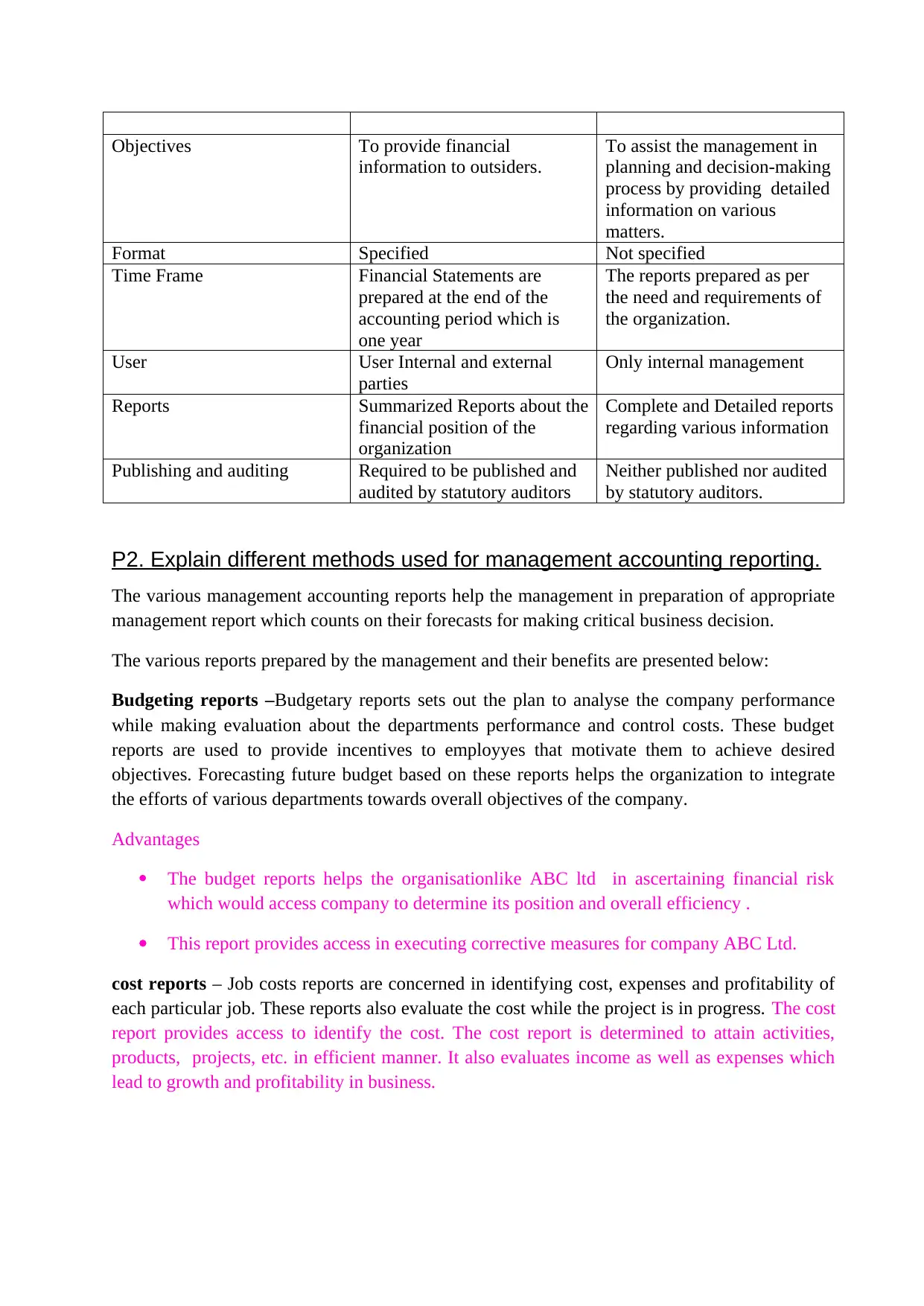
Objectives To provide financial
information to outsiders.
To assist the management in
planning and decision-making
process by providing detailed
information on various
matters.
Format Specified Not specified
Time Frame Financial Statements are
prepared at the end of the
accounting period which is
one year
The reports prepared as per
the need and requirements of
the organization.
User User Internal and external
parties
Only internal management
Reports Summarized Reports about the
financial position of the
organization
Complete and Detailed reports
regarding various information
Publishing and auditing Required to be published and
audited by statutory auditors
Neither published nor audited
by statutory auditors.
P2. Explain different methods used for management accounting reporting.
The various management accounting reports help the management in preparation of appropriate
management report which counts on their forecasts for making critical business decision.
The various reports prepared by the management and their benefits are presented below:
Budgeting reports –Budgetary reports sets out the plan to analyse the company performance
while making evaluation about the departments performance and control costs. These budget
reports are used to provide incentives to employyes that motivate them to achieve desired
objectives. Forecasting future budget based on these reports helps the organization to integrate
the efforts of various departments towards overall objectives of the company.
Advantages
The budget reports helps the organisationlike ABC ltd in ascertaining financial risk
which would access company to determine its position and overall efficiency .
This report provides access in executing corrective measures for company ABC Ltd.
cost reports – Job costs reports are concerned in identifying cost, expenses and profitability of
each particular job. These reports also evaluate the cost while the project is in progress. The cost
report provides access to identify the cost. The cost report is determined to attain activities,
products, projects, etc. in efficient manner. It also evaluates income as well as expenses which
lead to growth and profitability in business.
information to outsiders.
To assist the management in
planning and decision-making
process by providing detailed
information on various
matters.
Format Specified Not specified
Time Frame Financial Statements are
prepared at the end of the
accounting period which is
one year
The reports prepared as per
the need and requirements of
the organization.
User User Internal and external
parties
Only internal management
Reports Summarized Reports about the
financial position of the
organization
Complete and Detailed reports
regarding various information
Publishing and auditing Required to be published and
audited by statutory auditors
Neither published nor audited
by statutory auditors.
P2. Explain different methods used for management accounting reporting.
The various management accounting reports help the management in preparation of appropriate
management report which counts on their forecasts for making critical business decision.
The various reports prepared by the management and their benefits are presented below:
Budgeting reports –Budgetary reports sets out the plan to analyse the company performance
while making evaluation about the departments performance and control costs. These budget
reports are used to provide incentives to employyes that motivate them to achieve desired
objectives. Forecasting future budget based on these reports helps the organization to integrate
the efforts of various departments towards overall objectives of the company.
Advantages
The budget reports helps the organisationlike ABC ltd in ascertaining financial risk
which would access company to determine its position and overall efficiency .
This report provides access in executing corrective measures for company ABC Ltd.
cost reports – Job costs reports are concerned in identifying cost, expenses and profitability of
each particular job. These reports also evaluate the cost while the project is in progress. The cost
report provides access to identify the cost. The cost report is determined to attain activities,
products, projects, etc. in efficient manner. It also evaluates income as well as expenses which
lead to growth and profitability in business.
⊘ This is a preview!⊘
Do you want full access?
Subscribe today to unlock all pages.

Trusted by 1+ million students worldwide
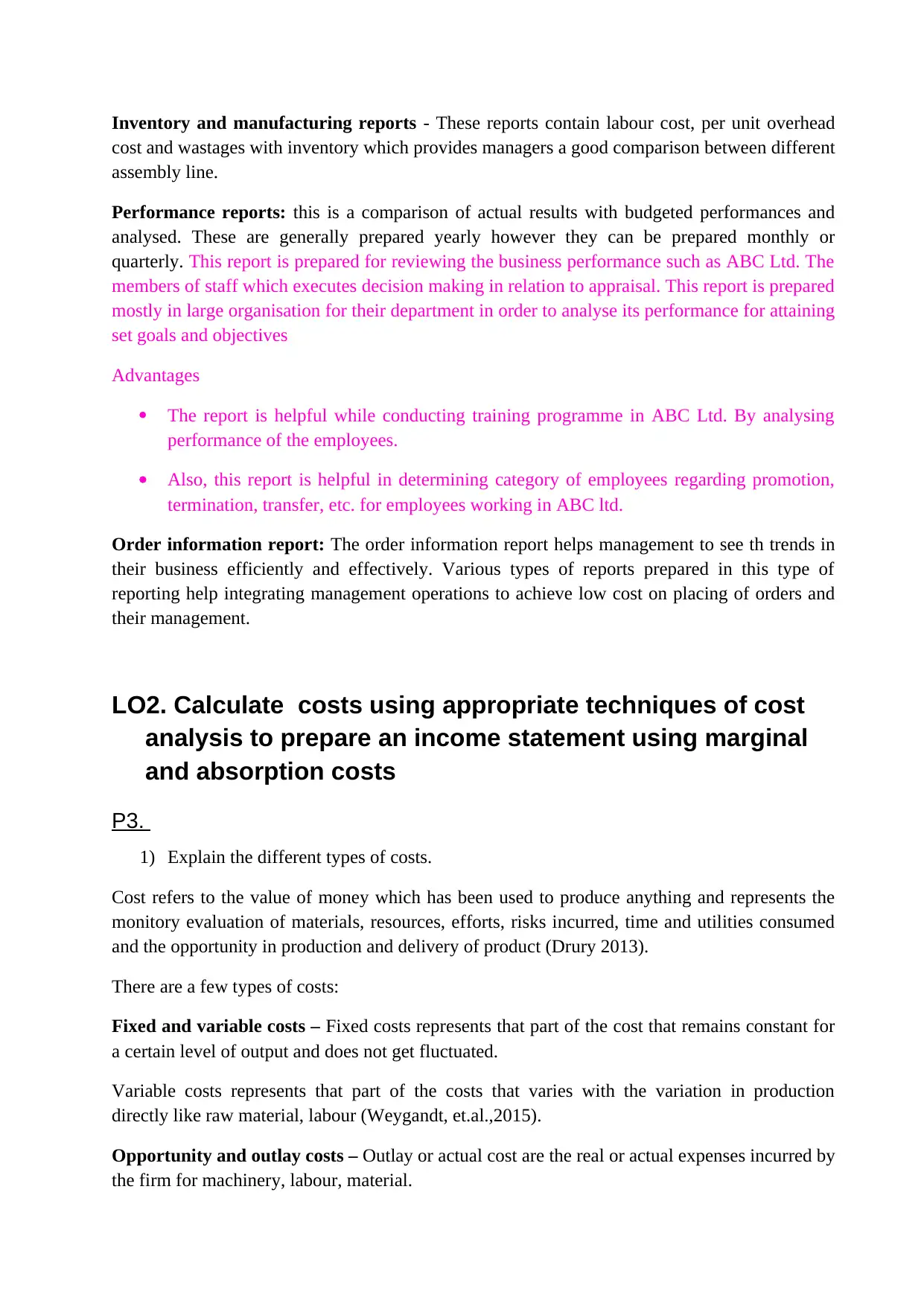
Inventory and manufacturing reports - These reports contain labour cost, per unit overhead
cost and wastages with inventory which provides managers a good comparison between different
assembly line.
Performance reports: this is a comparison of actual results with budgeted performances and
analysed. These are generally prepared yearly however they can be prepared monthly or
quarterly. This report is prepared for reviewing the business performance such as ABC Ltd. The
members of staff which executes decision making in relation to appraisal. This report is prepared
mostly in large organisation for their department in order to analyse its performance for attaining
set goals and objectives
Advantages
The report is helpful while conducting training programme in ABC Ltd. By analysing
performance of the employees.
Also, this report is helpful in determining category of employees regarding promotion,
termination, transfer, etc. for employees working in ABC ltd.
Order information report: The order information report helps management to see th trends in
their business efficiently and effectively. Various types of reports prepared in this type of
reporting help integrating management operations to achieve low cost on placing of orders and
their management.
LO2. Calculate costs using appropriate techniques of cost
analysis to prepare an income statement using marginal
and absorption costs
P3.
1) Explain the different types of costs.
Cost refers to the value of money which has been used to produce anything and represents the
monitory evaluation of materials, resources, efforts, risks incurred, time and utilities consumed
and the opportunity in production and delivery of product (Drury 2013).
There are a few types of costs:
Fixed and variable costs – Fixed costs represents that part of the cost that remains constant for
a certain level of output and does not get fluctuated.
Variable costs represents that part of the costs that varies with the variation in production
directly like raw material, labour (Weygandt, et.al.,2015).
Opportunity and outlay costs – Outlay or actual cost are the real or actual expenses incurred by
the firm for machinery, labour, material.
cost and wastages with inventory which provides managers a good comparison between different
assembly line.
Performance reports: this is a comparison of actual results with budgeted performances and
analysed. These are generally prepared yearly however they can be prepared monthly or
quarterly. This report is prepared for reviewing the business performance such as ABC Ltd. The
members of staff which executes decision making in relation to appraisal. This report is prepared
mostly in large organisation for their department in order to analyse its performance for attaining
set goals and objectives
Advantages
The report is helpful while conducting training programme in ABC Ltd. By analysing
performance of the employees.
Also, this report is helpful in determining category of employees regarding promotion,
termination, transfer, etc. for employees working in ABC ltd.
Order information report: The order information report helps management to see th trends in
their business efficiently and effectively. Various types of reports prepared in this type of
reporting help integrating management operations to achieve low cost on placing of orders and
their management.
LO2. Calculate costs using appropriate techniques of cost
analysis to prepare an income statement using marginal
and absorption costs
P3.
1) Explain the different types of costs.
Cost refers to the value of money which has been used to produce anything and represents the
monitory evaluation of materials, resources, efforts, risks incurred, time and utilities consumed
and the opportunity in production and delivery of product (Drury 2013).
There are a few types of costs:
Fixed and variable costs – Fixed costs represents that part of the cost that remains constant for
a certain level of output and does not get fluctuated.
Variable costs represents that part of the costs that varies with the variation in production
directly like raw material, labour (Weygandt, et.al.,2015).
Opportunity and outlay costs – Outlay or actual cost are the real or actual expenses incurred by
the firm for machinery, labour, material.
Paraphrase This Document
Need a fresh take? Get an instant paraphrase of this document with our AI Paraphraser
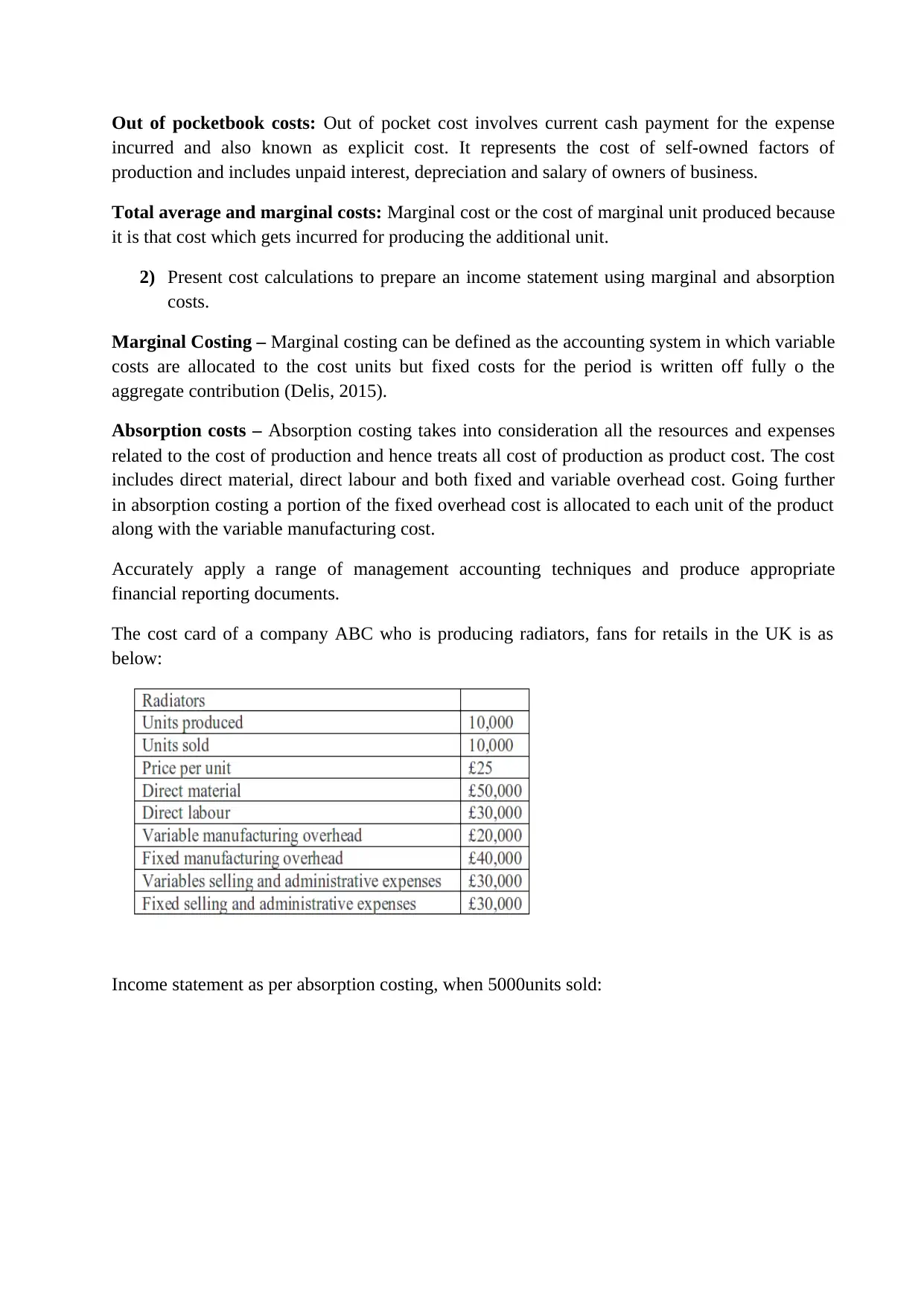
Out of pocketbook costs: Out of pocket cost involves current cash payment for the expense
incurred and also known as explicit cost. It represents the cost of self-owned factors of
production and includes unpaid interest, depreciation and salary of owners of business.
Total average and marginal costs: Marginal cost or the cost of marginal unit produced because
it is that cost which gets incurred for producing the additional unit.
2) Present cost calculations to prepare an income statement using marginal and absorption
costs.
Marginal Costing – Marginal costing can be defined as the accounting system in which variable
costs are allocated to the cost units but fixed costs for the period is written off fully o the
aggregate contribution (Delis, 2015).
Absorption costs – Absorption costing takes into consideration all the resources and expenses
related to the cost of production and hence treats all cost of production as product cost. The cost
includes direct material, direct labour and both fixed and variable overhead cost. Going further
in absorption costing a portion of the fixed overhead cost is allocated to each unit of the product
along with the variable manufacturing cost.
Accurately apply a range of management accounting techniques and produce appropriate
financial reporting documents.
The cost card of a company ABC who is producing radiators, fans for retails in the UK is as
below:
Income statement as per absorption costing, when 5000units sold:
incurred and also known as explicit cost. It represents the cost of self-owned factors of
production and includes unpaid interest, depreciation and salary of owners of business.
Total average and marginal costs: Marginal cost or the cost of marginal unit produced because
it is that cost which gets incurred for producing the additional unit.
2) Present cost calculations to prepare an income statement using marginal and absorption
costs.
Marginal Costing – Marginal costing can be defined as the accounting system in which variable
costs are allocated to the cost units but fixed costs for the period is written off fully o the
aggregate contribution (Delis, 2015).
Absorption costs – Absorption costing takes into consideration all the resources and expenses
related to the cost of production and hence treats all cost of production as product cost. The cost
includes direct material, direct labour and both fixed and variable overhead cost. Going further
in absorption costing a portion of the fixed overhead cost is allocated to each unit of the product
along with the variable manufacturing cost.
Accurately apply a range of management accounting techniques and produce appropriate
financial reporting documents.
The cost card of a company ABC who is producing radiators, fans for retails in the UK is as
below:
Income statement as per absorption costing, when 5000units sold:
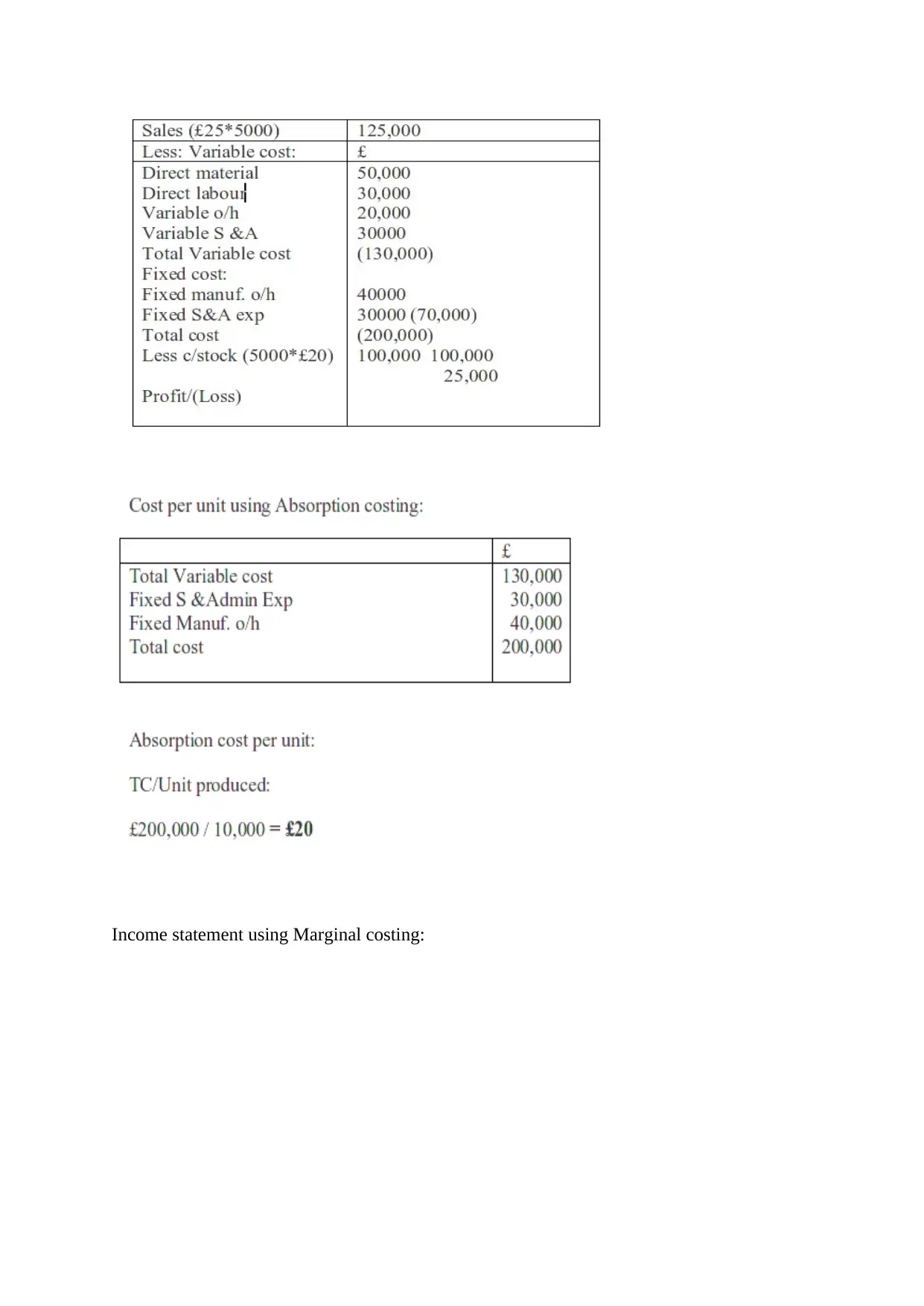
Income statement using Marginal costing:
⊘ This is a preview!⊘
Do you want full access?
Subscribe today to unlock all pages.

Trusted by 1+ million students worldwide
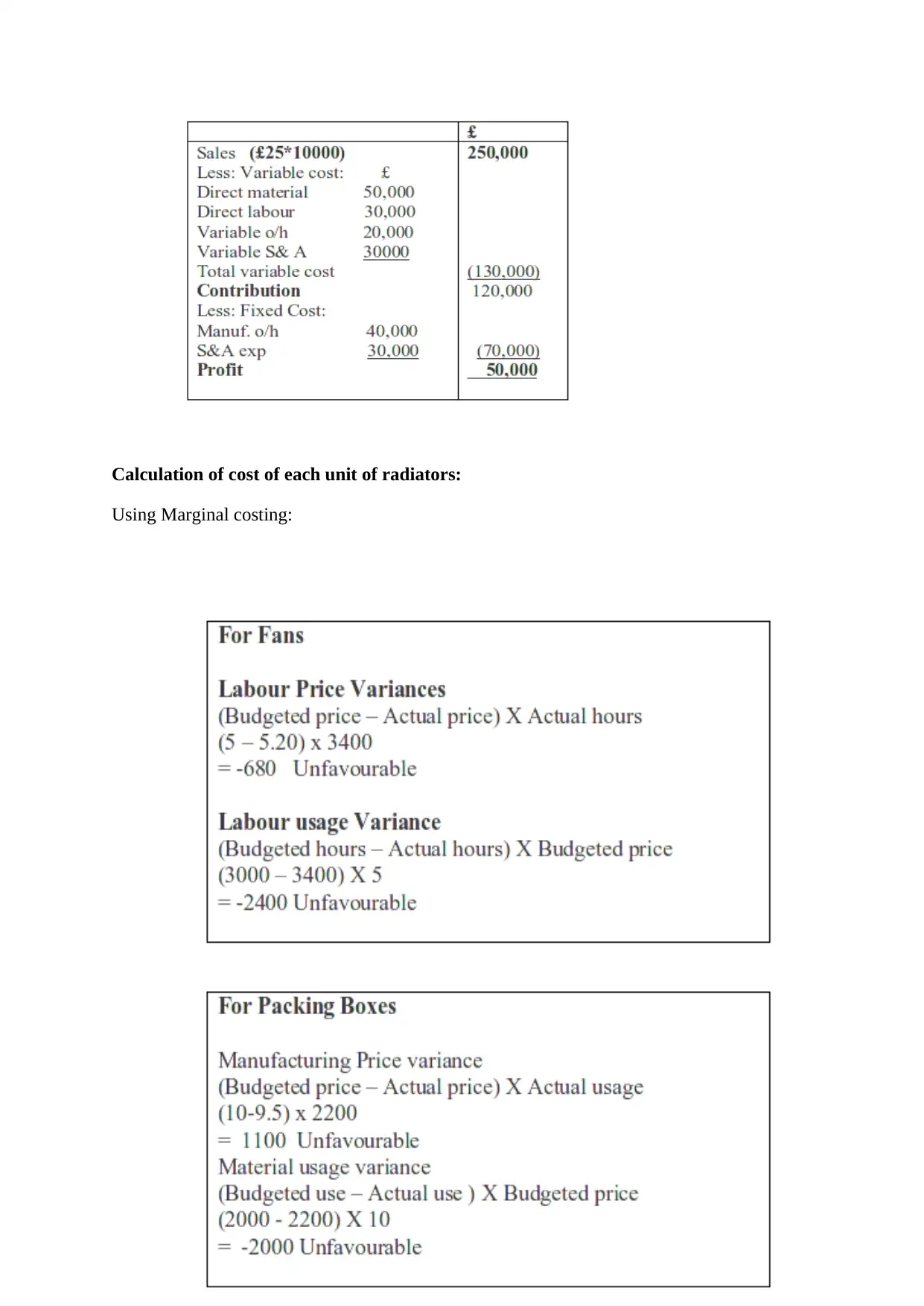
Calculation of cost of each unit of radiators:
Using Marginal costing:
Using Marginal costing:
Paraphrase This Document
Need a fresh take? Get an instant paraphrase of this document with our AI Paraphraser
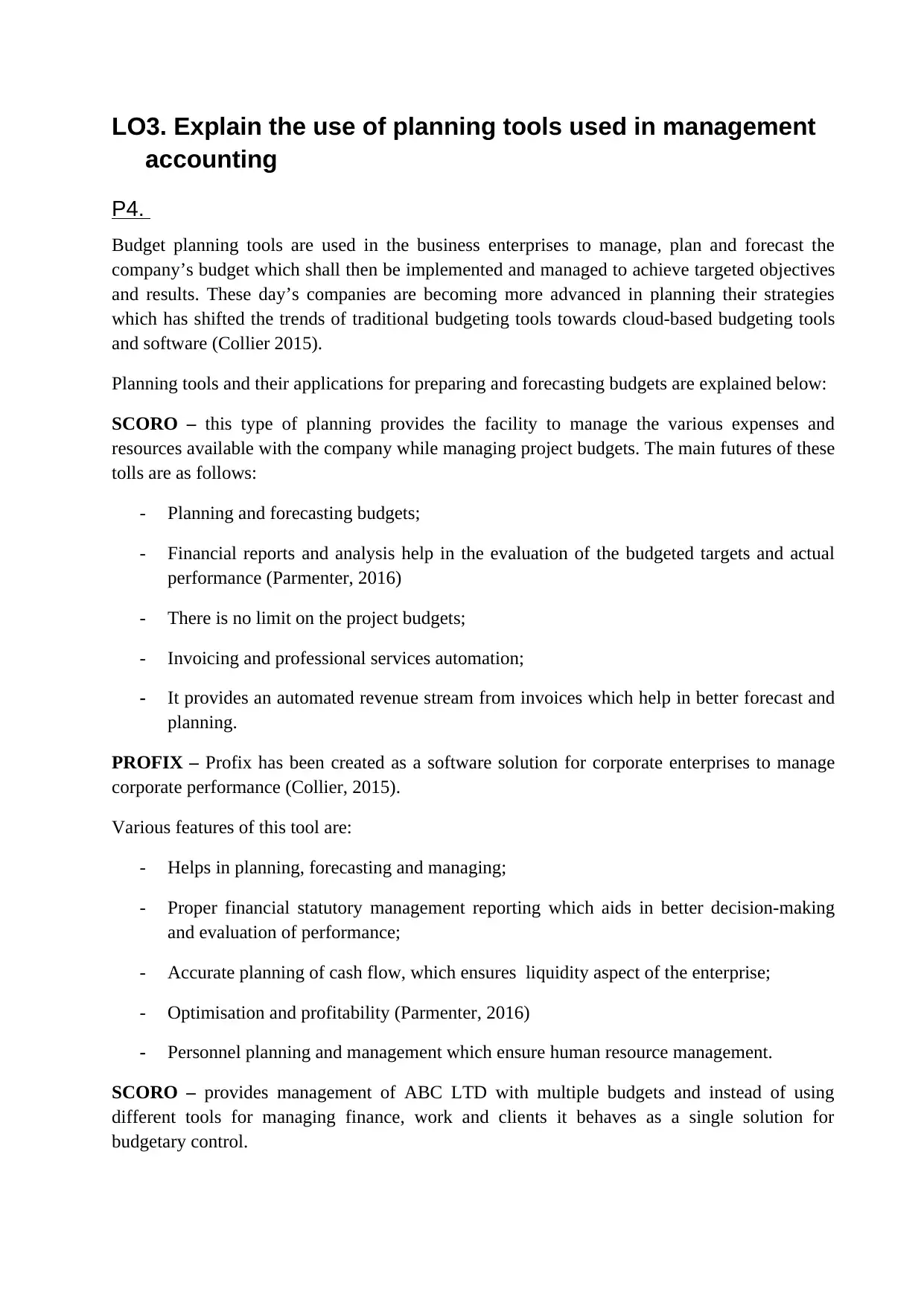
LO3. Explain the use of planning tools used in management
accounting
P4.
Budget planning tools are used in the business enterprises to manage, plan and forecast the
company’s budget which shall then be implemented and managed to achieve targeted objectives
and results. These day’s companies are becoming more advanced in planning their strategies
which has shifted the trends of traditional budgeting tools towards cloud-based budgeting tools
and software (Collier 2015).
Planning tools and their applications for preparing and forecasting budgets are explained below:
SCORO – this type of planning provides the facility to manage the various expenses and
resources available with the company while managing project budgets. The main futures of these
tolls are as follows:
- Planning and forecasting budgets;
- Financial reports and analysis help in the evaluation of the budgeted targets and actual
performance (Parmenter, 2016)
- There is no limit on the project budgets;
- Invoicing and professional services automation;
- It provides an automated revenue stream from invoices which help in better forecast and
planning.
PROFIX – Profix has been created as a software solution for corporate enterprises to manage
corporate performance (Collier, 2015).
Various features of this tool are:
- Helps in planning, forecasting and managing;
- Proper financial statutory management reporting which aids in better decision-making
and evaluation of performance;
- Accurate planning of cash flow, which ensures liquidity aspect of the enterprise;
- Optimisation and profitability (Parmenter, 2016)
- Personnel planning and management which ensure human resource management.
SCORO – provides management of ABC LTD with multiple budgets and instead of using
different tools for managing finance, work and clients it behaves as a single solution for
budgetary control.
accounting
P4.
Budget planning tools are used in the business enterprises to manage, plan and forecast the
company’s budget which shall then be implemented and managed to achieve targeted objectives
and results. These day’s companies are becoming more advanced in planning their strategies
which has shifted the trends of traditional budgeting tools towards cloud-based budgeting tools
and software (Collier 2015).
Planning tools and their applications for preparing and forecasting budgets are explained below:
SCORO – this type of planning provides the facility to manage the various expenses and
resources available with the company while managing project budgets. The main futures of these
tolls are as follows:
- Planning and forecasting budgets;
- Financial reports and analysis help in the evaluation of the budgeted targets and actual
performance (Parmenter, 2016)
- There is no limit on the project budgets;
- Invoicing and professional services automation;
- It provides an automated revenue stream from invoices which help in better forecast and
planning.
PROFIX – Profix has been created as a software solution for corporate enterprises to manage
corporate performance (Collier, 2015).
Various features of this tool are:
- Helps in planning, forecasting and managing;
- Proper financial statutory management reporting which aids in better decision-making
and evaluation of performance;
- Accurate planning of cash flow, which ensures liquidity aspect of the enterprise;
- Optimisation and profitability (Parmenter, 2016)
- Personnel planning and management which ensure human resource management.
SCORO – provides management of ABC LTD with multiple budgets and instead of using
different tools for managing finance, work and clients it behaves as a single solution for
budgetary control.
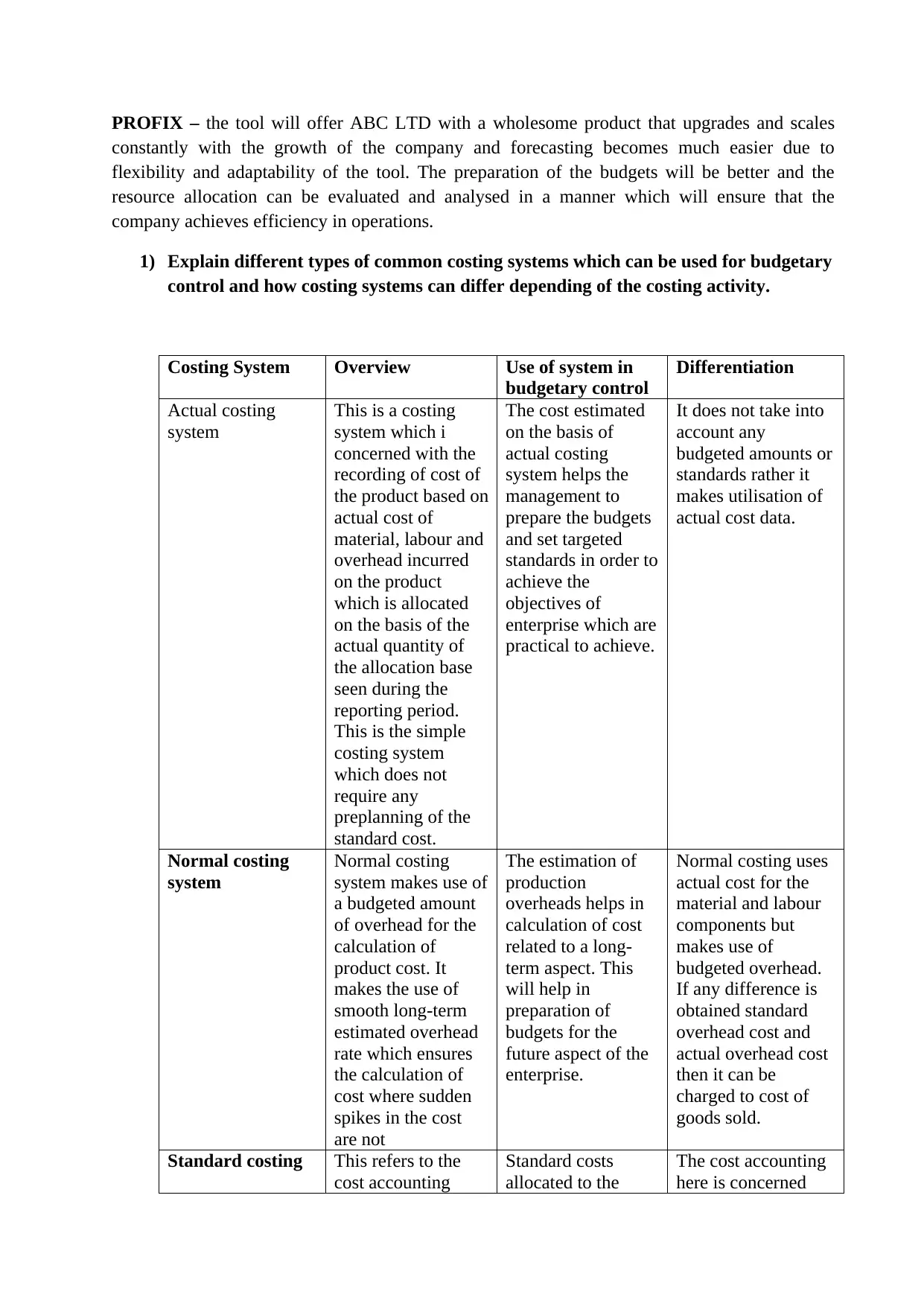
PROFIX – the tool will offer ABC LTD with a wholesome product that upgrades and scales
constantly with the growth of the company and forecasting becomes much easier due to
flexibility and adaptability of the tool. The preparation of the budgets will be better and the
resource allocation can be evaluated and analysed in a manner which will ensure that the
company achieves efficiency in operations.
1) Explain different types of common costing systems which can be used for budgetary
control and how costing systems can differ depending of the costing activity.
Costing System Overview Use of system in
budgetary control
Differentiation
Actual costing
system
This is a costing
system which i
concerned with the
recording of cost of
the product based on
actual cost of
material, labour and
overhead incurred
on the product
which is allocated
on the basis of the
actual quantity of
the allocation base
seen during the
reporting period.
This is the simple
costing system
which does not
require any
preplanning of the
standard cost.
The cost estimated
on the basis of
actual costing
system helps the
management to
prepare the budgets
and set targeted
standards in order to
achieve the
objectives of
enterprise which are
practical to achieve.
It does not take into
account any
budgeted amounts or
standards rather it
makes utilisation of
actual cost data.
Normal costing
system
Normal costing
system makes use of
a budgeted amount
of overhead for the
calculation of
product cost. It
makes the use of
smooth long-term
estimated overhead
rate which ensures
the calculation of
cost where sudden
spikes in the cost
are not
The estimation of
production
overheads helps in
calculation of cost
related to a long-
term aspect. This
will help in
preparation of
budgets for the
future aspect of the
enterprise.
Normal costing uses
actual cost for the
material and labour
components but
makes use of
budgeted overhead.
If any difference is
obtained standard
overhead cost and
actual overhead cost
then it can be
charged to cost of
goods sold.
Standard costing This refers to the
cost accounting
Standard costs
allocated to the
The cost accounting
here is concerned
constantly with the growth of the company and forecasting becomes much easier due to
flexibility and adaptability of the tool. The preparation of the budgets will be better and the
resource allocation can be evaluated and analysed in a manner which will ensure that the
company achieves efficiency in operations.
1) Explain different types of common costing systems which can be used for budgetary
control and how costing systems can differ depending of the costing activity.
Costing System Overview Use of system in
budgetary control
Differentiation
Actual costing
system
This is a costing
system which i
concerned with the
recording of cost of
the product based on
actual cost of
material, labour and
overhead incurred
on the product
which is allocated
on the basis of the
actual quantity of
the allocation base
seen during the
reporting period.
This is the simple
costing system
which does not
require any
preplanning of the
standard cost.
The cost estimated
on the basis of
actual costing
system helps the
management to
prepare the budgets
and set targeted
standards in order to
achieve the
objectives of
enterprise which are
practical to achieve.
It does not take into
account any
budgeted amounts or
standards rather it
makes utilisation of
actual cost data.
Normal costing
system
Normal costing
system makes use of
a budgeted amount
of overhead for the
calculation of
product cost. It
makes the use of
smooth long-term
estimated overhead
rate which ensures
the calculation of
cost where sudden
spikes in the cost
are not
The estimation of
production
overheads helps in
calculation of cost
related to a long-
term aspect. This
will help in
preparation of
budgets for the
future aspect of the
enterprise.
Normal costing uses
actual cost for the
material and labour
components but
makes use of
budgeted overhead.
If any difference is
obtained standard
overhead cost and
actual overhead cost
then it can be
charged to cost of
goods sold.
Standard costing This refers to the
cost accounting
Standard costs
allocated to the
The cost accounting
here is concerned
⊘ This is a preview!⊘
Do you want full access?
Subscribe today to unlock all pages.

Trusted by 1+ million students worldwide
1 out of 21
Related Documents
Your All-in-One AI-Powered Toolkit for Academic Success.
+13062052269
info@desklib.com
Available 24*7 on WhatsApp / Email
![[object Object]](/_next/static/media/star-bottom.7253800d.svg)
Unlock your academic potential
Copyright © 2020–2025 A2Z Services. All Rights Reserved. Developed and managed by ZUCOL.





